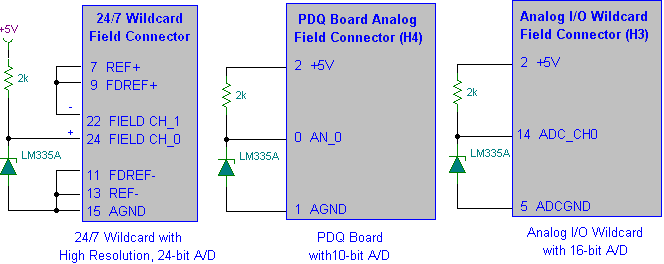Using the LM335 IC Temperature Sensor
Integrated circuit sensors, sometimes called diode temperature sensors, are small active electronic devices good for measuring temperatures below 150°C. The popular LM335A is a precision, easily-calibrated, integrated circuit temperature sensor.1) When biased with a resistor or constant current source, it behaves as a zener diode, but with a breakdown voltage directly proportional to absolute temperature. Its output voltage changes with temperature +10 mV/°K. Its uncalibrated temperature error is ±1°C at 25°C and within ±2°C over a range of -40 to +100°C.
You can measure its output with any A/D converter. The following diagram shows connections for measurement by the PDQ Board controller, the 24/7 Data Acquisition Wildcard, and the Analog I/O Wildcard.
The -40 to +100°C temperature range of the LM335A corresponds to an output signal of 2.33 to 3.73 volts. These voltages are within the common mode range of each of the three A/Ds, so they are easily converted directly. The diagram shows the connector pins to use for connecting the temperature sensor to each A/D device. There are particular considerations to keep in mind when using each A/D:
PDQ Board or the PDQ Board Lite – The PDQ Board or PDQ Board Lite's 10-bit A/D reads analog voltages with 5 mV resolution, and the LM335A produces a signal with 10mV/°K. Consequently, it can read the LM335A with 0.5°C resolution. The PDQ Board uses a +5V reference derived from its 5V power supply, so the accuracy of conversion depends on the accuracy of the 5V supplied to the board. For example, if the 5V supply is off by 1%, the measured temperature will be off by 1% of the absolute temperature measured, or about 3°C at room temperature.
Analog I/O Wildcard – To read the LM335A with the Analog I/O Wildcard you may set the Wildcard's jumpers to use either a 5V or 4.096V reference, as described in its users guide. The 4.096V reference is that with the greatest accuracy. Using the 4.096V reference, the A/D converter's 16-bit resolution provides a temperature resolution of 0.006°C. The absolute accuracy of the reading is limited by two factors:
- The accuracy of the reference voltage (±0.01V or ±0.24%FS, corresponding to ±0.24% of the absolute temperature reading, or ±0.73°C at room temperature); and,
- The accuracy of the LM335A (± 1 to 2°C).
24/7 Data Acquisition Wildcard – When using the 24/7 Wildcard you should use its 2.5V reference. You can then measure any difference voltage within the A/D's common mode input range of 0 to +5V. If you measure using a differential channel pair, with the negative input channel connected to the 2.5V reference you can then measure the full range of the LM335A. Its output of 2.33 to 3.73 volts, corresponding to -40 to +100°C, is measured as -0.17 V to 1.23 V, with high resolution. While the absolute accuracy of the reading is limited by the accuracy of the reference voltage (±0.005V, corresponding to ±0.5°C) and the LM335A's off-the-shelf accuracy (± 1 to 2°C), you can measure extremely small temperature changes, with a noise-limited resolution of approximately 18-bits, or 0.001°C resolution.
See also → Measuring Temperature

